Organizational Leadership and Decision-Making: Datatronics Case Study
VerifiedAdded on 2023/01/18
|8
|1789
|99
Case Study
AI Summary
This case study analyzes the customer service challenges faced by Datatronics, a company that recently took over E-Z-RP. The study focuses on the role of Matt Rubenzahl, who was tasked with improving customer service functions. The analysis explores the need for specific, time-bound goals and the importance of gathering quantitative metrics, customer feedback, and CSR insights. The study recommends strategic moves such as changing metrics, standardizing documentation, investing in CSRs, and streamlining customer calls, including removing the IVR system. The case highlights the importance of customer service for business success and the need for management to prioritize CSRs and end-customer satisfaction for long-term sustainability. The analysis also discusses the importance of aligning strategies with leadership preferences, such as Joel's emphasis on cost-effectiveness. The study references several academic papers and articles to support the analysis.
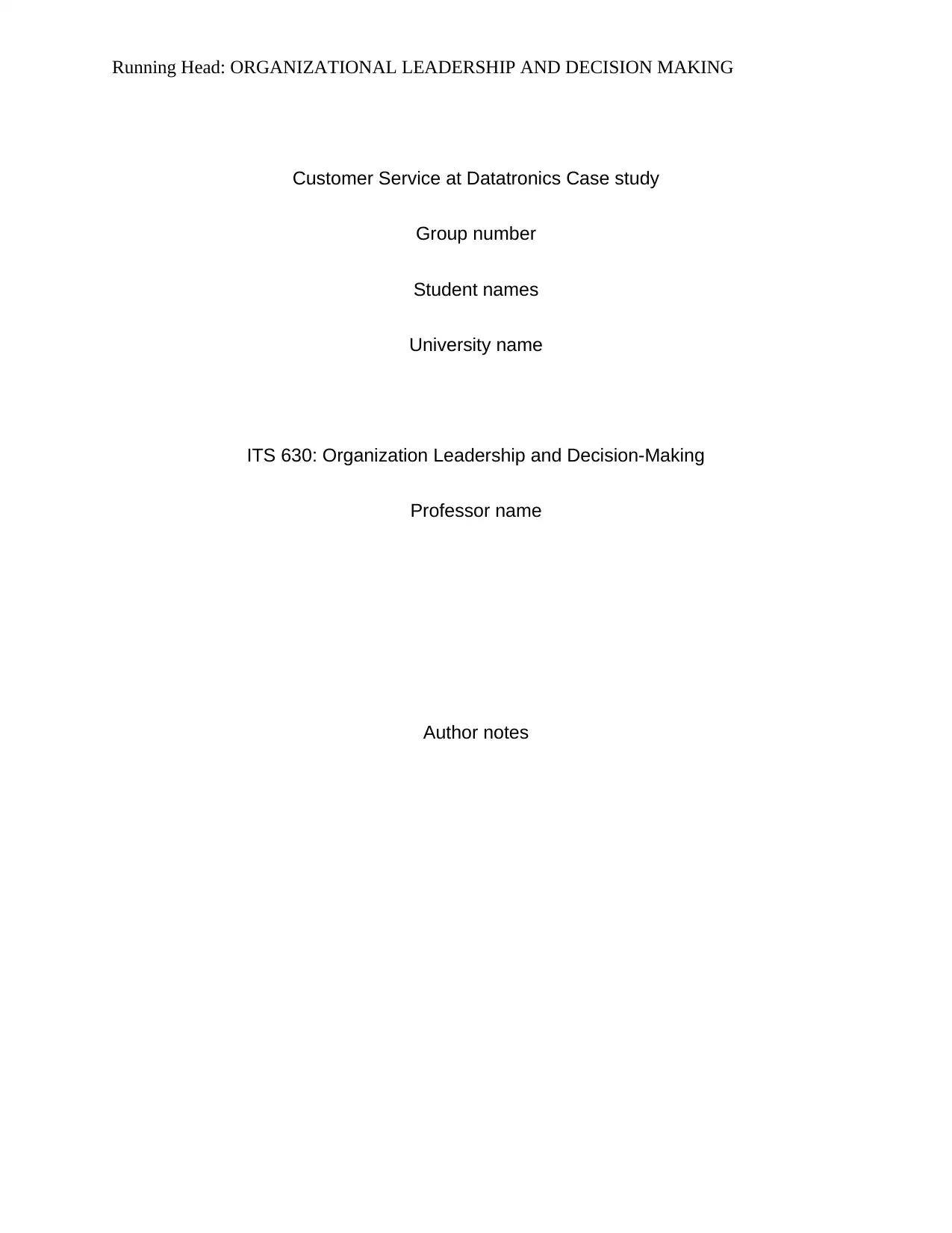
Running Head: ORGANIZATIONAL LEADERSHIP AND DECISION MAKING
Customer Service at Datatronics Case study
Group number
Student names
University name
ITS 630: Organization Leadership and Decision-Making
Professor name
Author notes
Customer Service at Datatronics Case study
Group number
Student names
University name
ITS 630: Organization Leadership and Decision-Making
Professor name
Author notes
Paraphrase This Document
Need a fresh take? Get an instant paraphrase of this document with our AI Paraphraser
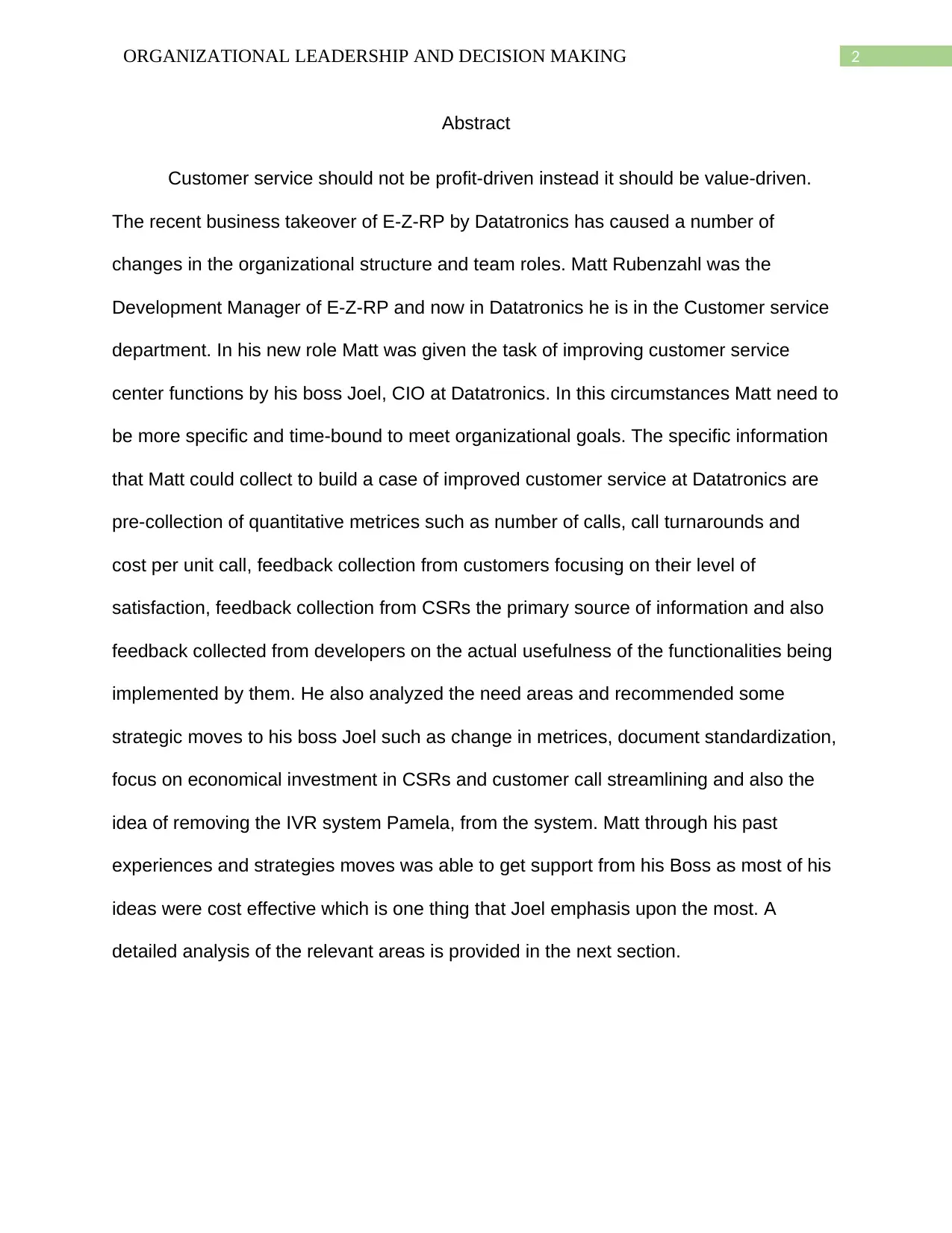
2ORGANIZATIONAL LEADERSHIP AND DECISION MAKING
Abstract
Customer service should not be profit-driven instead it should be value-driven.
The recent business takeover of E-Z-RP by Datatronics has caused a number of
changes in the organizational structure and team roles. Matt Rubenzahl was the
Development Manager of E-Z-RP and now in Datatronics he is in the Customer service
department. In his new role Matt was given the task of improving customer service
center functions by his boss Joel, CIO at Datatronics. In this circumstances Matt need to
be more specific and time-bound to meet organizational goals. The specific information
that Matt could collect to build a case of improved customer service at Datatronics are
pre-collection of quantitative metrices such as number of calls, call turnarounds and
cost per unit call, feedback collection from customers focusing on their level of
satisfaction, feedback collection from CSRs the primary source of information and also
feedback collected from developers on the actual usefulness of the functionalities being
implemented by them. He also analyzed the need areas and recommended some
strategic moves to his boss Joel such as change in metrices, document standardization,
focus on economical investment in CSRs and customer call streamlining and also the
idea of removing the IVR system Pamela, from the system. Matt through his past
experiences and strategies moves was able to get support from his Boss as most of his
ideas were cost effective which is one thing that Joel emphasis upon the most. A
detailed analysis of the relevant areas is provided in the next section.
Abstract
Customer service should not be profit-driven instead it should be value-driven.
The recent business takeover of E-Z-RP by Datatronics has caused a number of
changes in the organizational structure and team roles. Matt Rubenzahl was the
Development Manager of E-Z-RP and now in Datatronics he is in the Customer service
department. In his new role Matt was given the task of improving customer service
center functions by his boss Joel, CIO at Datatronics. In this circumstances Matt need to
be more specific and time-bound to meet organizational goals. The specific information
that Matt could collect to build a case of improved customer service at Datatronics are
pre-collection of quantitative metrices such as number of calls, call turnarounds and
cost per unit call, feedback collection from customers focusing on their level of
satisfaction, feedback collection from CSRs the primary source of information and also
feedback collected from developers on the actual usefulness of the functionalities being
implemented by them. He also analyzed the need areas and recommended some
strategic moves to his boss Joel such as change in metrices, document standardization,
focus on economical investment in CSRs and customer call streamlining and also the
idea of removing the IVR system Pamela, from the system. Matt through his past
experiences and strategies moves was able to get support from his Boss as most of his
ideas were cost effective which is one thing that Joel emphasis upon the most. A
detailed analysis of the relevant areas is provided in the next section.
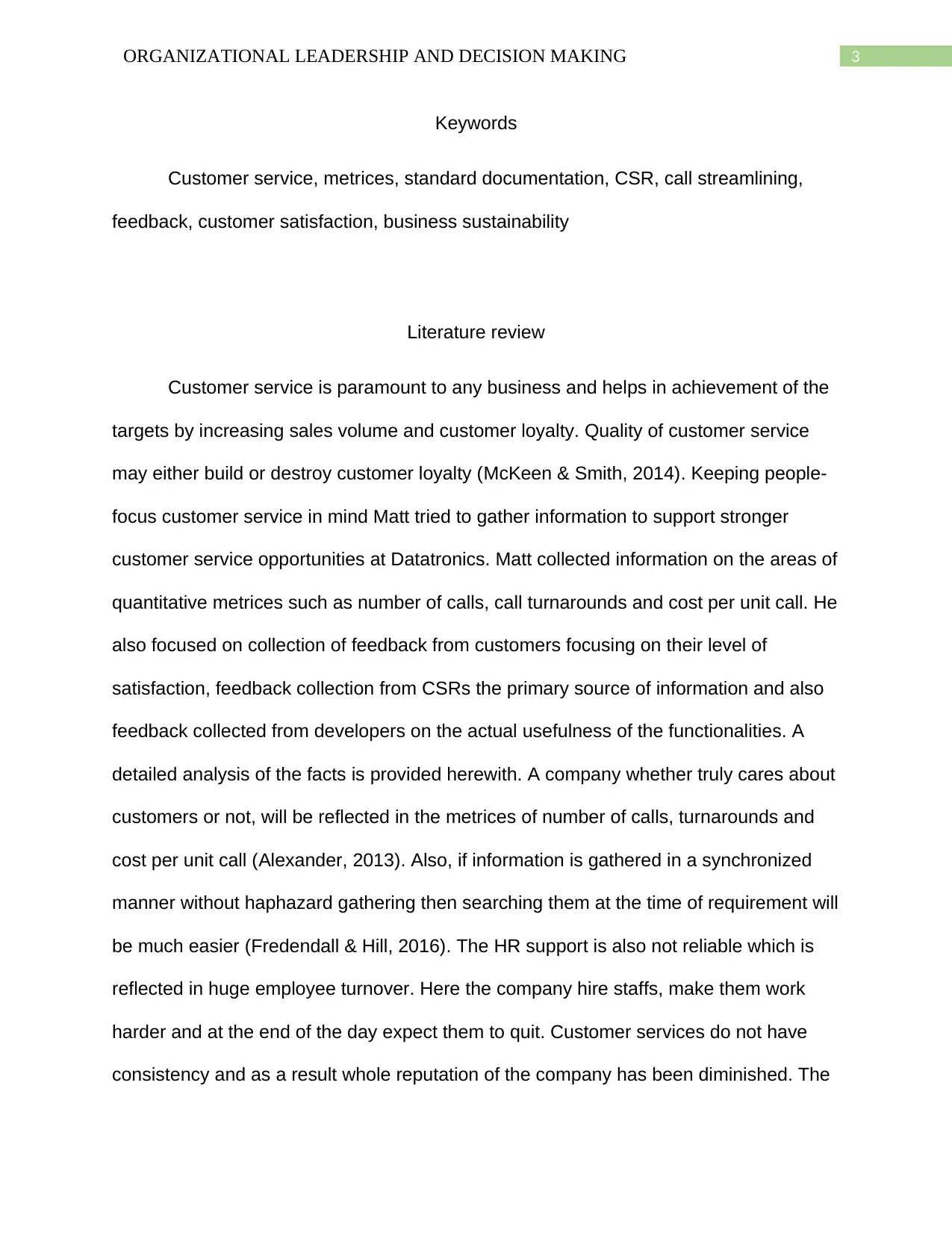
3ORGANIZATIONAL LEADERSHIP AND DECISION MAKING
Keywords
Customer service, metrices, standard documentation, CSR, call streamlining,
feedback, customer satisfaction, business sustainability
Literature review
Customer service is paramount to any business and helps in achievement of the
targets by increasing sales volume and customer loyalty. Quality of customer service
may either build or destroy customer loyalty (McKeen & Smith, 2014). Keeping people-
focus customer service in mind Matt tried to gather information to support stronger
customer service opportunities at Datatronics. Matt collected information on the areas of
quantitative metrices such as number of calls, call turnarounds and cost per unit call. He
also focused on collection of feedback from customers focusing on their level of
satisfaction, feedback collection from CSRs the primary source of information and also
feedback collected from developers on the actual usefulness of the functionalities. A
detailed analysis of the facts is provided herewith. A company whether truly cares about
customers or not, will be reflected in the metrices of number of calls, turnarounds and
cost per unit call (Alexander, 2013). Also, if information is gathered in a synchronized
manner without haphazard gathering then searching them at the time of requirement will
be much easier (Fredendall & Hill, 2016). The HR support is also not reliable which is
reflected in huge employee turnover. Here the company hire staffs, make them work
harder and at the end of the day expect them to quit. Customer services do not have
consistency and as a result whole reputation of the company has been diminished. The
Keywords
Customer service, metrices, standard documentation, CSR, call streamlining,
feedback, customer satisfaction, business sustainability
Literature review
Customer service is paramount to any business and helps in achievement of the
targets by increasing sales volume and customer loyalty. Quality of customer service
may either build or destroy customer loyalty (McKeen & Smith, 2014). Keeping people-
focus customer service in mind Matt tried to gather information to support stronger
customer service opportunities at Datatronics. Matt collected information on the areas of
quantitative metrices such as number of calls, call turnarounds and cost per unit call. He
also focused on collection of feedback from customers focusing on their level of
satisfaction, feedback collection from CSRs the primary source of information and also
feedback collected from developers on the actual usefulness of the functionalities. A
detailed analysis of the facts is provided herewith. A company whether truly cares about
customers or not, will be reflected in the metrices of number of calls, turnarounds and
cost per unit call (Alexander, 2013). Also, if information is gathered in a synchronized
manner without haphazard gathering then searching them at the time of requirement will
be much easier (Fredendall & Hill, 2016). The HR support is also not reliable which is
reflected in huge employee turnover. Here the company hire staffs, make them work
harder and at the end of the day expect them to quit. Customer services do not have
consistency and as a result whole reputation of the company has been diminished. The
⊘ This is a preview!⊘
Do you want full access?
Subscribe today to unlock all pages.

Trusted by 1+ million students worldwide
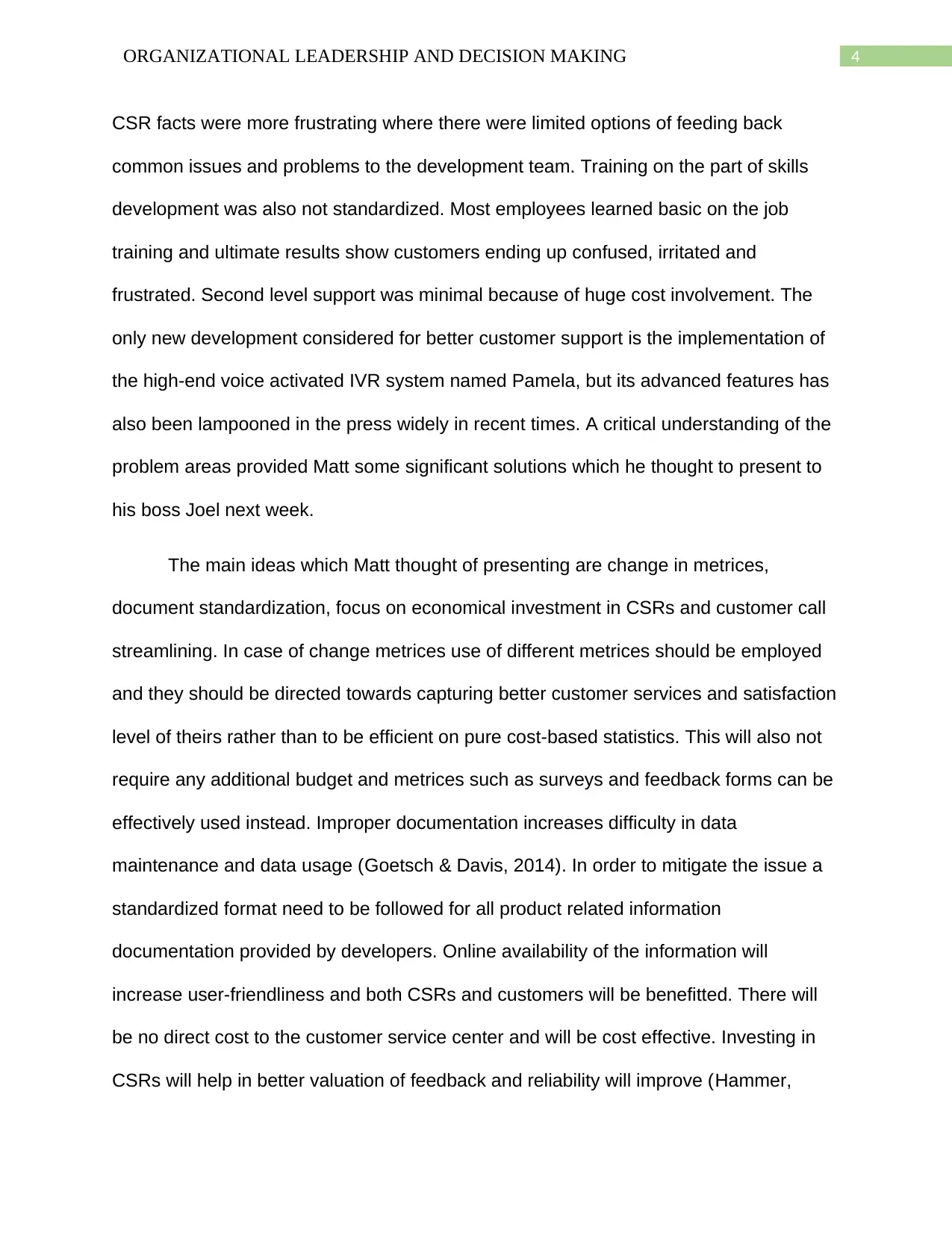
4ORGANIZATIONAL LEADERSHIP AND DECISION MAKING
CSR facts were more frustrating where there were limited options of feeding back
common issues and problems to the development team. Training on the part of skills
development was also not standardized. Most employees learned basic on the job
training and ultimate results show customers ending up confused, irritated and
frustrated. Second level support was minimal because of huge cost involvement. The
only new development considered for better customer support is the implementation of
the high-end voice activated IVR system named Pamela, but its advanced features has
also been lampooned in the press widely in recent times. A critical understanding of the
problem areas provided Matt some significant solutions which he thought to present to
his boss Joel next week.
The main ideas which Matt thought of presenting are change in metrices,
document standardization, focus on economical investment in CSRs and customer call
streamlining. In case of change metrices use of different metrices should be employed
and they should be directed towards capturing better customer services and satisfaction
level of theirs rather than to be efficient on pure cost-based statistics. This will also not
require any additional budget and metrices such as surveys and feedback forms can be
effectively used instead. Improper documentation increases difficulty in data
maintenance and data usage (Goetsch & Davis, 2014). In order to mitigate the issue a
standardized format need to be followed for all product related information
documentation provided by developers. Online availability of the information will
increase user-friendliness and both CSRs and customers will be benefitted. There will
be no direct cost to the customer service center and will be cost effective. Investing in
CSRs will help in better valuation of feedback and reliability will improve (Hammer,
CSR facts were more frustrating where there were limited options of feeding back
common issues and problems to the development team. Training on the part of skills
development was also not standardized. Most employees learned basic on the job
training and ultimate results show customers ending up confused, irritated and
frustrated. Second level support was minimal because of huge cost involvement. The
only new development considered for better customer support is the implementation of
the high-end voice activated IVR system named Pamela, but its advanced features has
also been lampooned in the press widely in recent times. A critical understanding of the
problem areas provided Matt some significant solutions which he thought to present to
his boss Joel next week.
The main ideas which Matt thought of presenting are change in metrices,
document standardization, focus on economical investment in CSRs and customer call
streamlining. In case of change metrices use of different metrices should be employed
and they should be directed towards capturing better customer services and satisfaction
level of theirs rather than to be efficient on pure cost-based statistics. This will also not
require any additional budget and metrices such as surveys and feedback forms can be
effectively used instead. Improper documentation increases difficulty in data
maintenance and data usage (Goetsch & Davis, 2014). In order to mitigate the issue a
standardized format need to be followed for all product related information
documentation provided by developers. Online availability of the information will
increase user-friendliness and both CSRs and customers will be benefitted. There will
be no direct cost to the customer service center and will be cost effective. Investing in
CSRs will help in better valuation of feedback and reliability will improve (Hammer,
Paraphrase This Document
Need a fresh take? Get an instant paraphrase of this document with our AI Paraphraser
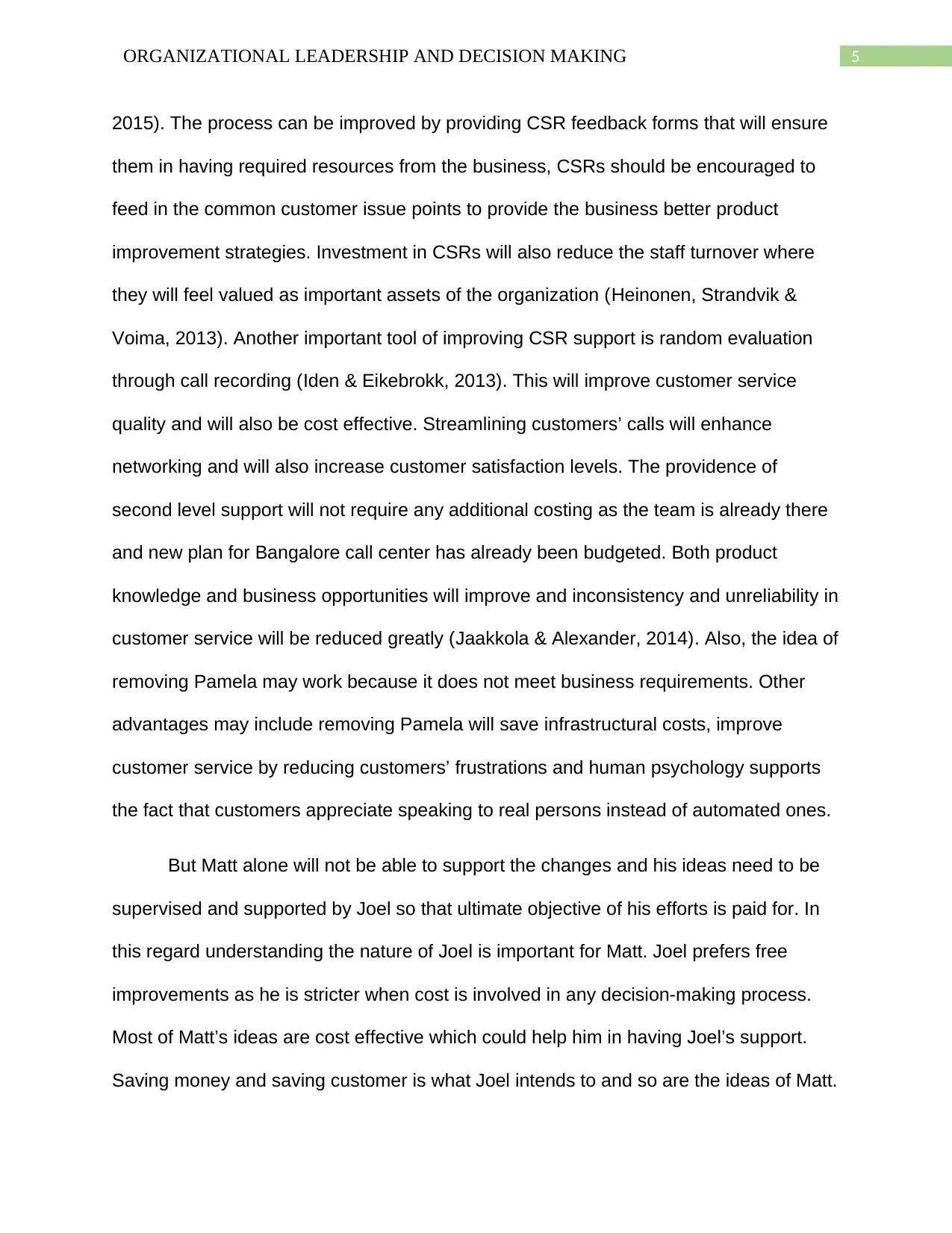
5ORGANIZATIONAL LEADERSHIP AND DECISION MAKING
2015). The process can be improved by providing CSR feedback forms that will ensure
them in having required resources from the business, CSRs should be encouraged to
feed in the common customer issue points to provide the business better product
improvement strategies. Investment in CSRs will also reduce the staff turnover where
they will feel valued as important assets of the organization (Heinonen, Strandvik &
Voima, 2013). Another important tool of improving CSR support is random evaluation
through call recording (Iden & Eikebrokk, 2013). This will improve customer service
quality and will also be cost effective. Streamlining customers’ calls will enhance
networking and will also increase customer satisfaction levels. The providence of
second level support will not require any additional costing as the team is already there
and new plan for Bangalore call center has already been budgeted. Both product
knowledge and business opportunities will improve and inconsistency and unreliability in
customer service will be reduced greatly (Jaakkola & Alexander, 2014). Also, the idea of
removing Pamela may work because it does not meet business requirements. Other
advantages may include removing Pamela will save infrastructural costs, improve
customer service by reducing customers’ frustrations and human psychology supports
the fact that customers appreciate speaking to real persons instead of automated ones.
But Matt alone will not be able to support the changes and his ideas need to be
supervised and supported by Joel so that ultimate objective of his efforts is paid for. In
this regard understanding the nature of Joel is important for Matt. Joel prefers free
improvements as he is stricter when cost is involved in any decision-making process.
Most of Matt’s ideas are cost effective which could help him in having Joel’s support.
Saving money and saving customer is what Joel intends to and so are the ideas of Matt.
2015). The process can be improved by providing CSR feedback forms that will ensure
them in having required resources from the business, CSRs should be encouraged to
feed in the common customer issue points to provide the business better product
improvement strategies. Investment in CSRs will also reduce the staff turnover where
they will feel valued as important assets of the organization (Heinonen, Strandvik &
Voima, 2013). Another important tool of improving CSR support is random evaluation
through call recording (Iden & Eikebrokk, 2013). This will improve customer service
quality and will also be cost effective. Streamlining customers’ calls will enhance
networking and will also increase customer satisfaction levels. The providence of
second level support will not require any additional costing as the team is already there
and new plan for Bangalore call center has already been budgeted. Both product
knowledge and business opportunities will improve and inconsistency and unreliability in
customer service will be reduced greatly (Jaakkola & Alexander, 2014). Also, the idea of
removing Pamela may work because it does not meet business requirements. Other
advantages may include removing Pamela will save infrastructural costs, improve
customer service by reducing customers’ frustrations and human psychology supports
the fact that customers appreciate speaking to real persons instead of automated ones.
But Matt alone will not be able to support the changes and his ideas need to be
supervised and supported by Joel so that ultimate objective of his efforts is paid for. In
this regard understanding the nature of Joel is important for Matt. Joel prefers free
improvements as he is stricter when cost is involved in any decision-making process.
Most of Matt’s ideas are cost effective which could help him in having Joel’s support.
Saving money and saving customer is what Joel intends to and so are the ideas of Matt.
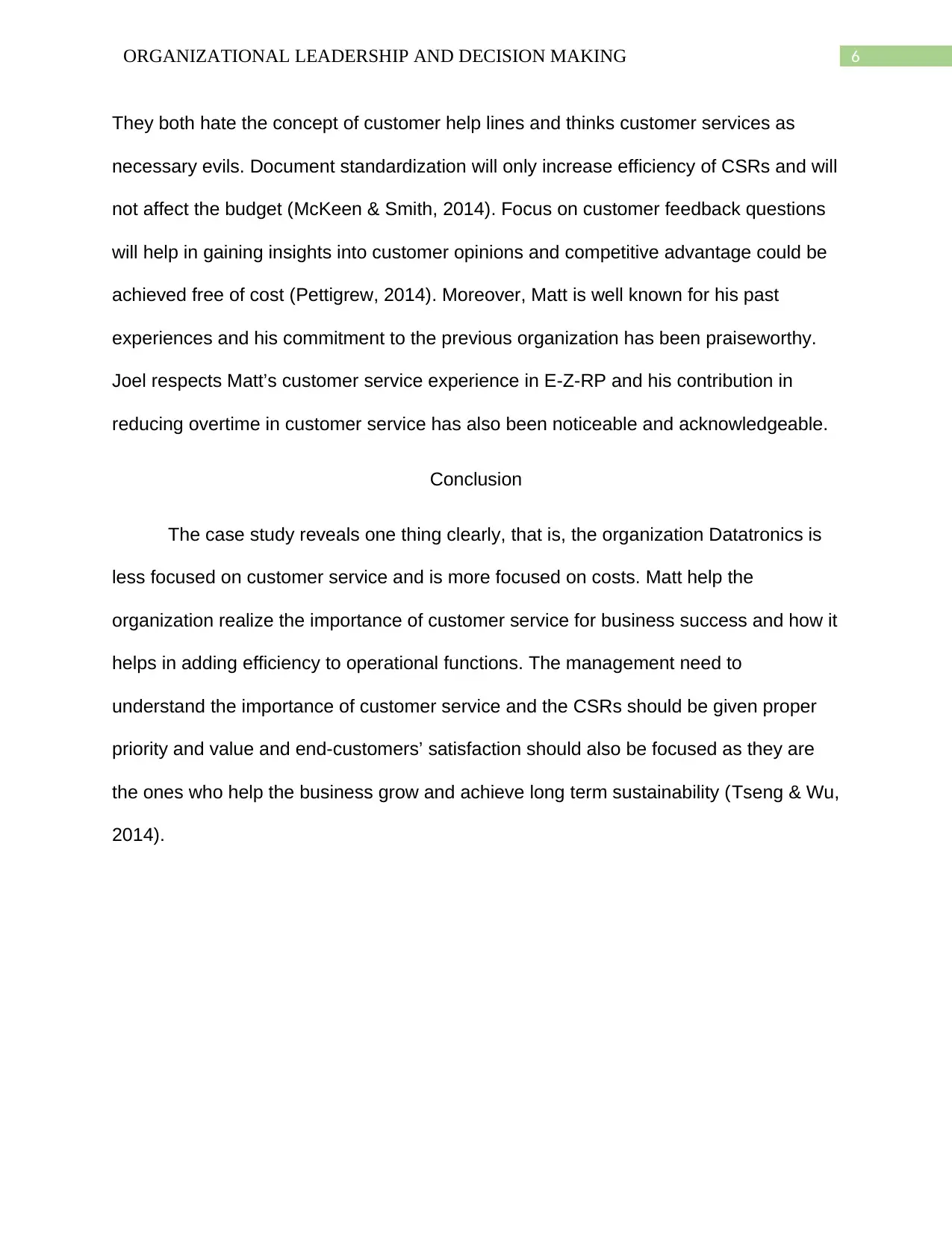
6ORGANIZATIONAL LEADERSHIP AND DECISION MAKING
They both hate the concept of customer help lines and thinks customer services as
necessary evils. Document standardization will only increase efficiency of CSRs and will
not affect the budget (McKeen & Smith, 2014). Focus on customer feedback questions
will help in gaining insights into customer opinions and competitive advantage could be
achieved free of cost (Pettigrew, 2014). Moreover, Matt is well known for his past
experiences and his commitment to the previous organization has been praiseworthy.
Joel respects Matt’s customer service experience in E-Z-RP and his contribution in
reducing overtime in customer service has also been noticeable and acknowledgeable.
Conclusion
The case study reveals one thing clearly, that is, the organization Datatronics is
less focused on customer service and is more focused on costs. Matt help the
organization realize the importance of customer service for business success and how it
helps in adding efficiency to operational functions. The management need to
understand the importance of customer service and the CSRs should be given proper
priority and value and end-customers’ satisfaction should also be focused as they are
the ones who help the business grow and achieve long term sustainability (Tseng & Wu,
2014).
They both hate the concept of customer help lines and thinks customer services as
necessary evils. Document standardization will only increase efficiency of CSRs and will
not affect the budget (McKeen & Smith, 2014). Focus on customer feedback questions
will help in gaining insights into customer opinions and competitive advantage could be
achieved free of cost (Pettigrew, 2014). Moreover, Matt is well known for his past
experiences and his commitment to the previous organization has been praiseworthy.
Joel respects Matt’s customer service experience in E-Z-RP and his contribution in
reducing overtime in customer service has also been noticeable and acknowledgeable.
Conclusion
The case study reveals one thing clearly, that is, the organization Datatronics is
less focused on customer service and is more focused on costs. Matt help the
organization realize the importance of customer service for business success and how it
helps in adding efficiency to operational functions. The management need to
understand the importance of customer service and the CSRs should be given proper
priority and value and end-customers’ satisfaction should also be focused as they are
the ones who help the business grow and achieve long term sustainability (Tseng & Wu,
2014).
⊘ This is a preview!⊘
Do you want full access?
Subscribe today to unlock all pages.

Trusted by 1+ million students worldwide
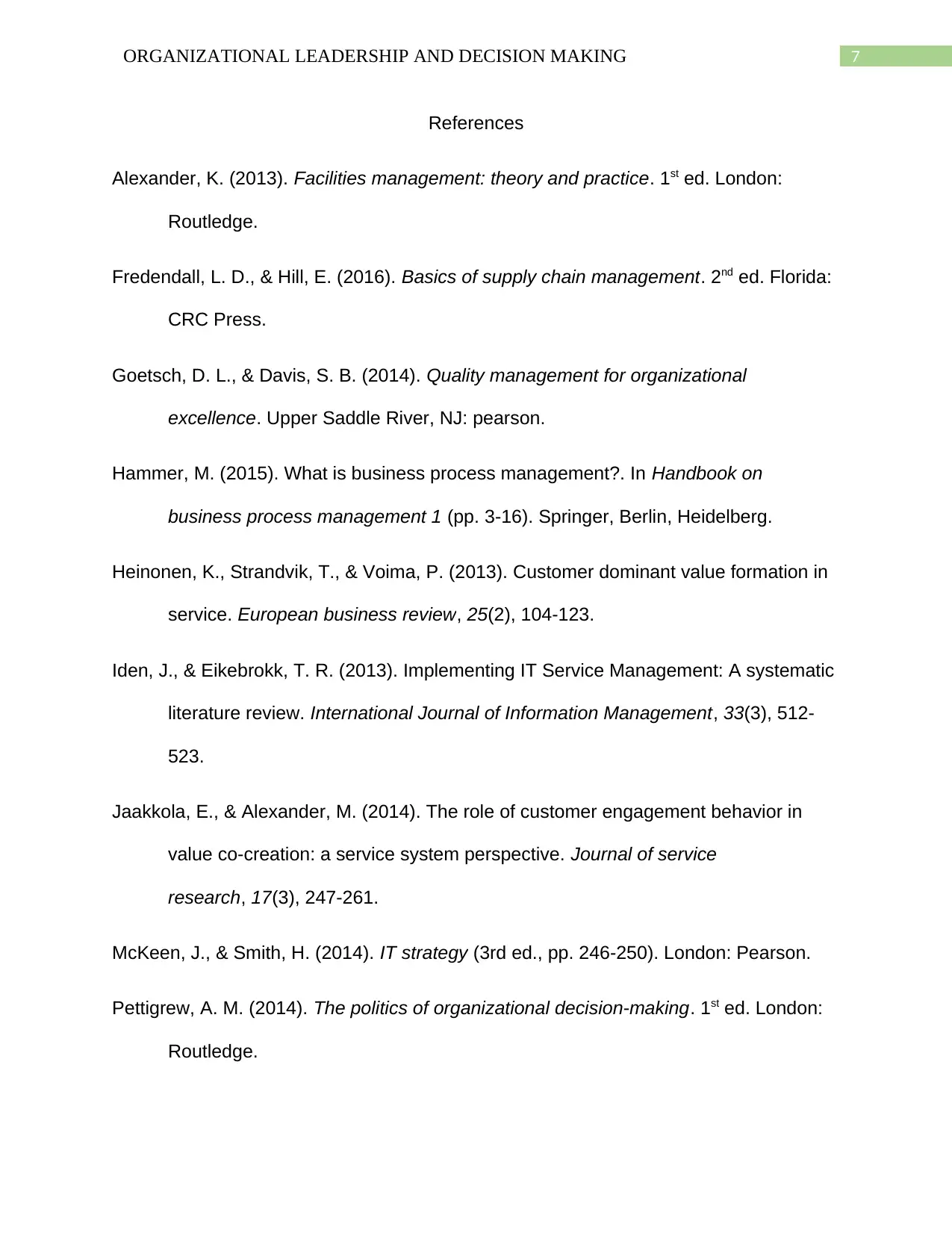
7ORGANIZATIONAL LEADERSHIP AND DECISION MAKING
References
Alexander, K. (2013). Facilities management: theory and practice. 1st ed. London:
Routledge.
Fredendall, L. D., & Hill, E. (2016). Basics of supply chain management. 2nd ed. Florida:
CRC Press.
Goetsch, D. L., & Davis, S. B. (2014). Quality management for organizational
excellence. Upper Saddle River, NJ: pearson.
Hammer, M. (2015). What is business process management?. In Handbook on
business process management 1 (pp. 3-16). Springer, Berlin, Heidelberg.
Heinonen, K., Strandvik, T., & Voima, P. (2013). Customer dominant value formation in
service. European business review, 25(2), 104-123.
Iden, J., & Eikebrokk, T. R. (2013). Implementing IT Service Management: A systematic
literature review. International Journal of Information Management, 33(3), 512-
523.
Jaakkola, E., & Alexander, M. (2014). The role of customer engagement behavior in
value co-creation: a service system perspective. Journal of service
research, 17(3), 247-261.
McKeen, J., & Smith, H. (2014). IT strategy (3rd ed., pp. 246-250). London: Pearson.
Pettigrew, A. M. (2014). The politics of organizational decision-making. 1st ed. London:
Routledge.
References
Alexander, K. (2013). Facilities management: theory and practice. 1st ed. London:
Routledge.
Fredendall, L. D., & Hill, E. (2016). Basics of supply chain management. 2nd ed. Florida:
CRC Press.
Goetsch, D. L., & Davis, S. B. (2014). Quality management for organizational
excellence. Upper Saddle River, NJ: pearson.
Hammer, M. (2015). What is business process management?. In Handbook on
business process management 1 (pp. 3-16). Springer, Berlin, Heidelberg.
Heinonen, K., Strandvik, T., & Voima, P. (2013). Customer dominant value formation in
service. European business review, 25(2), 104-123.
Iden, J., & Eikebrokk, T. R. (2013). Implementing IT Service Management: A systematic
literature review. International Journal of Information Management, 33(3), 512-
523.
Jaakkola, E., & Alexander, M. (2014). The role of customer engagement behavior in
value co-creation: a service system perspective. Journal of service
research, 17(3), 247-261.
McKeen, J., & Smith, H. (2014). IT strategy (3rd ed., pp. 246-250). London: Pearson.
Pettigrew, A. M. (2014). The politics of organizational decision-making. 1st ed. London:
Routledge.
Paraphrase This Document
Need a fresh take? Get an instant paraphrase of this document with our AI Paraphraser
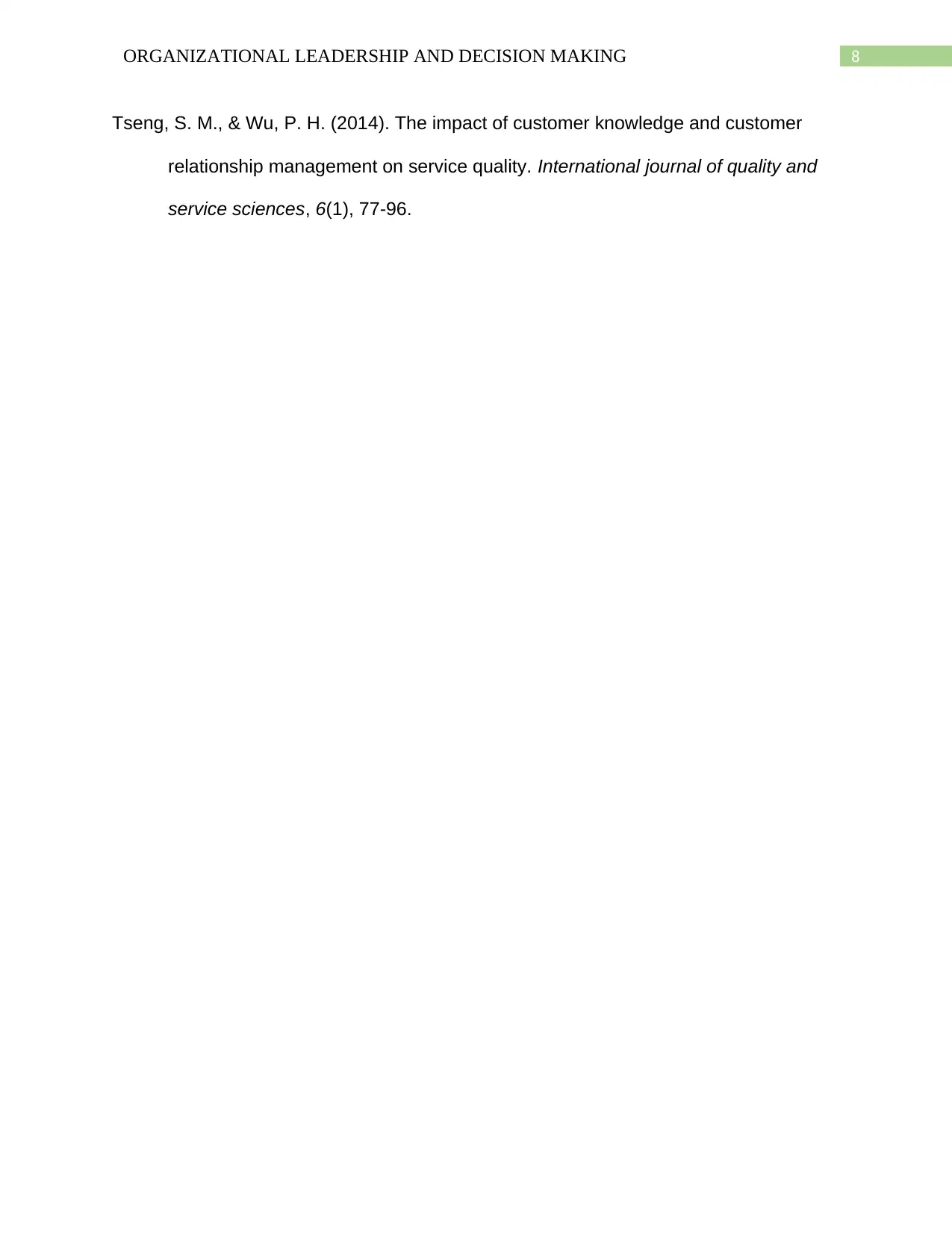
8ORGANIZATIONAL LEADERSHIP AND DECISION MAKING
Tseng, S. M., & Wu, P. H. (2014). The impact of customer knowledge and customer
relationship management on service quality. International journal of quality and
service sciences, 6(1), 77-96.
Tseng, S. M., & Wu, P. H. (2014). The impact of customer knowledge and customer
relationship management on service quality. International journal of quality and
service sciences, 6(1), 77-96.
1 out of 8
Your All-in-One AI-Powered Toolkit for Academic Success.
+13062052269
info@desklib.com
Available 24*7 on WhatsApp / Email
![[object Object]](/_next/static/media/star-bottom.7253800d.svg)
Unlock your academic potential
Copyright © 2020–2025 A2Z Services. All Rights Reserved. Developed and managed by ZUCOL.
